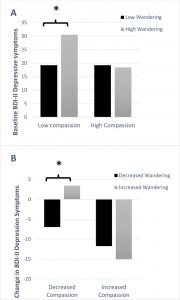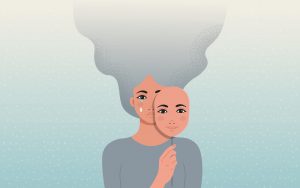Brain Activity Predicts the Effectiveness of Dialectical Behavior Therapy for Borderline Personality Disorder
By John M. de Castro, Ph.D.
“Dialectical behavior therapy (DBT). . . is a type of psychotherapy, sometimes called “talk therapy,” used to treat borderline personality disorder (BPD). DBT is a form of cognitive behavioral therapy (CBT).” – Kristalyn Salters-Pedneault
Borderline Personality Disorder (BPD) is a very serious mental illness that is estimated to affect 1.6% of the U.S. population. It involves unstable moods, behavior, and relationships, problems with regulating emotions and thoughts, impulsive and reckless behavior, and unstable relationships. BPD is associated with high rates of co-occurring depression, anxiety disorders, substance abuse, eating disorders, self-harm, suicidal behaviors, and completed suicides. Needless to say, it is widespread and debilitating.
One of the few treatments that appears to be effective for Borderline Personality Disorder (BPD) is Dialectical Behavior Therapy (DBT). It is targeted at changing the problem behaviors characteristic of BPD including self-injury. Behavior change is accomplished through focusing on changing the thoughts and emotions that precede problem behaviors, as well as by solving the problems faced by individuals that contribute to problematic thoughts, feelings and behaviors. In DBT five core skills are practiced; mindfulness, distress tolerance, emotion regulation, the middle path, and interpersonal effectiveness.
The nervous system is a dynamic entity, constantly changing and adapting to the environment. It will change size, activity, and connectivity in response to experience. These changes in the brain are called neuroplasticity. It is unknown how Dialectical Behavior Therapy may interact with brain systems to improve the responsiveness of Borderline Personality Disorder (BPD) to Dialectical Behavior Therapy (DBT).
In today’s Research News article “Individualized treatment response prediction of dialectical behavior therapy for borderline personality disorder using multimodal magnetic resonance imaging.” (See summary below or view the full text of the study at: https://www.ncbi.nlm.nih.gov/pmc/articles/PMC6749487/), Schmitgen and colleagues recruited female patients suffering from Borderline Personality Disorder (BPD) who were treated with a 12-week program of Dialectical Behavior Therapy (DBT). They were classified into patients who had significantly benefited from treatment (responders) and those who did not (non-responders). Prior to the therapy the participants underwent functional Magnetic Resonance Imaging (fMRI) of their brains while performing cognitive reappraisal, sensory distraction and cognitive distraction tasks. They were also measured for BPD symptom severity, emotion regulation, dissociative experiences, anxiety, depression, and working memory.
They found that before treatment responders had significantly higher levels of borderline symptoms and borderline severity and higher anxiety levels than non-responders. They also found that activation of the amygdala and parahippocampus areas during a cognitive reappraisal task, along with borderline personality disorder severity and the gray matter volume of the amygdala produced the best predictors of responders vs. non-responders.
It appears that Dialectical Behavior Therapy (DBT) for Borderline Personality Disorder (BPD) works best with patients who have the most severe symptoms and whose amygdala and parahippocampus areas are largest and respond most to a cognitive reappraisal task. These areas are associated with the brain systems underlying emotion regulation. Hence, the results suggest that particularly severe borderline patients whose brains respond best to emotional stimuli are the best responders to DBT. This suggests that the patients whose brains are best able to regulate emotions respond best to DBT.
Hence, brain activity predicts the effectiveness of Dialectical Behavior Therapy (DBT) for Borderline Personality Disorder (BPD).
“one thing that has really helped in my recovery process, I would say dialectical behavior therapy. I eat, sleep and breathe DBT. I can give you a damn good crash course in mindfulness, which is a core concept in DBT. I can teach you about self-validation. I can spoon-feed you lessons and lessons on interpersonal effectiveness. DBT has truly been a gift to me.” – Borderline Beauty
CMCS – Center for Mindfulness and Contemplative Studies
This and other Contemplative Studies posts are also available on Google+ https://plus.google.com/106784388191201299496/posts and on Twitter @MindfulResearch
Study Summary
Schmitgen, M. M., Niedtfeld, I., Schmitt, R., Mancke, F., Winter, D., Schmahl, C., & Herpertz, S. C. (2019). Individualized treatment response prediction of dialectical behavior therapy for borderline personality disorder using multimodal magnetic resonance imaging. Brain and behavior, 9(9), e01384. doi:10.1002/brb3.1384
Abstract
Introduction
Individualized treatment prediction is crucial for the development and selection of personalized psychiatric interventions. Here, we use random forest classification via pretreatment clinical and demographical (CD), functional, and structural magnetic resonance imaging (MRI) data from patients with borderline personality disorder (BPD) to predict individual treatment response.
Methods
Before dialectical behavior therapy (DBT), 31 female patients underwent functional (three different emotion regulation tasks) and structural MRI. DBT response was predicted using CD and MRI data in previously identified anatomical regions, which have been reported to be multimodally affected in BPD.
Results
Amygdala and parahippocampus activation during a cognitive reappraisal task (in contrasts displaying neural activation for emotional challenge and for regulation), along with severity measures of BPD psychopathology and gray matter volume of the amygdala, provided best predictive power with neuronal hyperractivities in nonresponders. All models, except one model using CD data solely, achieved significantly better accuracy (>70.25%) than a simple all‐respond model, with sensitivity and specificity of >0.7 and >0.7, as well as positive and negative likelihood ratios of >2.74 and <0.36 each. Surprisingly, a model combining all data modalities only reached rank five of seven. Among the functional tasks, only the activation elicited by a cognitive reappraisal paradigm yielded sufficient predictive power to enter the final models.
Conclusion
This proof of principle study shows that it is possible to achieve good predictions of psychotherapy outcome to find the most valid predictors among numerous variables via using a random forest classification approach.
https://www.ncbi.nlm.nih.gov/pmc/articles/PMC6749487/









